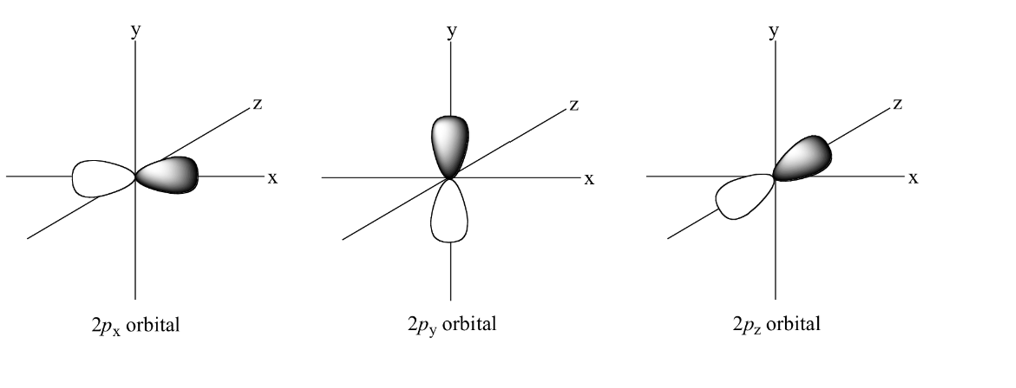9.1: Answer Key
- Page ID
- 25806
Electromagnetic Radiation
1. a) gamma rays
3. Gamma rays < X-rays < Ultraviolet < Visible Light < Infrared < Microwaves < Radio Waves
The Quantum Mechanical Model
5.

Electron Configurations
7. a) Li: 1s22s1
b) N: 1s22s22p3
c) Cl: 1s22s22p63s23p5
d) Ga: 1s22s22p63s23p64s23d104p1
9. a) Xe: 1s22s22p63s23p64s23d104p65s24d105p6
b) Ag: 1s22s22p63s23p64s23d104p65s24d9
c) Cs: 1s22s22p63s23p64s23d104p65s24d105p66s1
d) Hg: 1s22s22p63s23p64s23d104p65s24d105p66s24f145d10
11.
a) P:
1s 2s 2p 3s 3p
↑↓ ↑↓ ↑↓ ↑↓ ↑↓ ↑↓ ↑ ↑ ↑
3 unpaired electrons
b) K:
1s 2s 2p 3s 3p 4s
↑↓ ↑↓ ↑↓ ↑↓ ↑↓ ↑↓ ↑↓ ↑↓ ↑↓ ↑_
1 unpaired electron
c) He:
1s
↑↓
No unpaired electrons
d) Al:
1s 2s 2p 3s 3p
↑↓ ↑↓ ↑↓ ↑↓ ↑↓ ↑↓ ↑
1 unpaired electron
13. a) Nb: [Kr] 5s24d3
b) Se: [Ar] 4s23d104p4
c) Ca: [Ar] 4s1
d) Zn: [Ar] 4s23d10
15. Write the noble gas electron configuration for the following elements.
a) In: [Kr] 5s24d105p1
b) Ba: [Xe] 6s2
c) V: [Ar] 4s23d3
d) Y: [Kr] 5s24d1
Valence Electrons
17. a) Cd:
5s
↑↓
No unpaired electrons
b) Na:
3s
↑_
1 unpaired electron
c) I:
5s 5p
↑↓ ↑↓ ↑↓ ↑_
1 unpaired electron
d) Sn:
5s 5p
↑↓ ↑ ↑ __
2 unpaired electrons
Electron Configurations and the Period Table
19. a) 1A: _s1
b) 5A: _s2_p3
c) 6A: _s2_p4
21. a) 8A: _s2_p6
b) 2A: _s2
23. a) Ra: [Rn] 7s2
b) Pd: [Kr] 5s24d8
c) Br: [Ar] 4s23d104p5
d) Po: [Xe] 6s24f145d106p4
25. a) At: [Xe] 6s24f145d106p5
b) Pb: [Xe] 6s24f145d106p2
c) Ba: [Xe] 6s2
d) Ce: [Xe] 6s24f1
27. a) Re: [Xe] 6s24f145d5
b) Al: [Ne] 3s23p1
c) Lr: [Rn] 7s25f14
d) Os: [Xe] 6s24f145d6
29. a) Mg: 2 b) K: 2 c) Na: 1
d) Li: Lithium does not have a 3s orbital shell, therefore there are zero 3s electrons
31. a) Te b) Sr c) Nb d) In
33. a) As b) Ge c) Cu d) K
35. a) No b) C c) Kr d) W
Periodic Trends
37. a) Rb b) Te c) Ge d) Pb
39. a) Y b) K c) Tc d) Cs
41. O < Kr < Be < Sr < K
Cumulative Challenge Problems
43. a) n=1, 2 b) n=2, 8 c) n=3, 18 d) n=4, 32
45. a) Mn2+: [Ar] 3d5
b) Al3+: [He] 2s22p6 or [Ne]
c) I-: [Kr] 5s24d105p6 or [Xe]
d) Li+: [He]
47. P3- ,S2- ,Cl- , K+ , Ca2+

